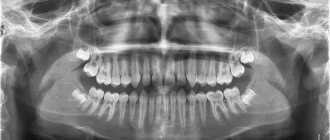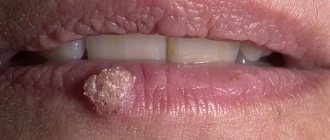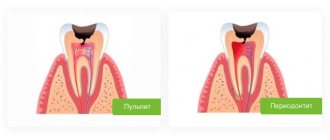Warts are skin growths in the form of nodules or papillae. This is the most common skin pathology, occurring in more than 90% of the world's population. Warts can appear in any person, at any age, on absolutely all areas of the skin, from the face to the feet. The disease is often contagious, it all depends on the person’s immune system.
COST OF TREATING WARTS IN OUR CLINIC IN ST. PETERSBURG
| Wart removal price | from 500 rub. |
| Dermatologist appointment | 1000 rub. |
| Dermatoscopy | 500 rub. |
| Call free: 8-800-707-1560 *The clinic is licensed to provide these services | |
What causes warts
The content of the article
There is a common belief that touching a frog causes warts to appear. It's a delusion. The causative agent of the disease, which results in the formation of warts, is human papillomavirus infection. According to statistics, this infection causes about 20% of all cancers.
The risk of HPV infection increases significantly:
- when using other people's personal hygiene items and items of common use;
- in public places (swimming pool, bathhouse, etc.), especially when walking there barefoot;
- in case of skin damage;
- with increased sweating of the hands and feet;
- upon contact with an infected person (handshake, sexual contact, etc.);
- when walking in tight, uncomfortable shoes that cause friction on the skin of the foot;
- when using non-sterile instruments (in a beauty salon, etc.).
The infection can remain in the human body for 3 to 6 months without showing itself in any way. Its “activator” and indirect culprit for the appearance of warts is weakened immunity.
Reasons for appearance
“What causes condylomas?” - a question that worries patients with a similar problem. The route of infection with condylomas is through unprotected sexual contact. Moreover, these include traditional intimate relationships, as well as oral, anal and homosexual relationships. Children get the disease from sick women while moving through the birth canal. Do not be negligent about household methods of infection. There is no need to take risks and use other people’s personal belongings, especially bath accessories (washcloth, towel, flip flops, etc.). Condylomas are activated under the influence of certain factors:
- indiscriminate unprotected sex;
- early onset of intimate relationships;
- sexual contacts with partners with condylomas or HPV carriers;
- decreased immune abilities of the body;
- previous diseases of the genital tract;
- frequent stress, vitamin deficiency;
- sloppiness and failure to comply with personal hygiene rules.
The appearance of genital warts is often associated with HPV. Human papillomavirus infection poses a great danger for the development of cancer. Condylomas of this etiology are the object of study and treatment by doctors of different specializations: in women - by gynecologists, in men - by urologists. If the location of condylomas is in the anal area, then a proctologist leads the patients. You should definitely consult about genital warts, because the development of the disease can occur in a variety of ways - from self-healing to the degeneration of condylomas into malignant formations. The specialists of the Global Clinic Center have accumulated positive experience in solving such problems, so contacting the clinic is a prerequisite for successful treatment of the patient.
Are warts always dangerous?
Most warts are completely harmless and can theoretically disappear in a few weeks or at most a month. In this case, patients are more likely to be concerned about a serious cosmetic defect, which causes psychological discomfort and interferes with leading a full lifestyle.
Warts are often painless unless they are on the soles of the feet or another part of the body that is subject to shock or constant contact. But there are cases of itching and discomfort in the affected area.
But as mentioned above, warts are viral in nature, so you cannot expect that the neoplasm will go away on its own or will not bother you for the rest of your life. Any wart should be shown to a dermatologist, and if he deems it necessary, it should be removed using one of the safe methods.
How to treat an abscess on the gum?
If an abscess or fistula appears, then you should not expect that the situation will resolve on its own: you need to make an appointment with a dentist. Treatment of an abscess on a baby tooth and a molar one will be different.
The appearance of an abscess on a baby tooth indicates periodontal inflammation. Such teeth must be removed, since the inflammatory process in the upper part of the root, accompanied by the formation of pus, may well spoil the molar, which will soon erupt in place of the milk tooth. This happens because the roots of temporary teeth are located next to the rudiments of molars. Bad bacteria and infection can also enter the lymph nodes under the jaw, causing them to become inflamed. The occurrence of a fistula means that pus will constantly seep into the mouth, which can cause the development of tonsillitis, since the tonsils will become infected. Various colds in a child are a direct consequence of an abscess on a tooth. Also, do not forget that toxins formed in the area of inflammation will definitely enter the bloodstream: this can result in allergic reactions, asthma and other serious general somatic diseases.
If we are talking about an abscess on a molar, then ordinary treatment is required for adults (provided that the tooth is not fundamentally damaged and can still be saved from removal).
Having discovered an abscess in a child, you should not try to cure it on your own. You can easily find a lot of advice on the Internet on how to relieve inflammation, but no amount of rinsing or even taking powerful antibiotics can eliminate the inflammatory focus located at the root of the tooth. Moreover, it is useless to hope that the tooth ache will stop. A bursting lump (this often happens) indicates only a short respite, during which, meanwhile, bacteria will still continue to enter the bloodstream and spread throughout the body. This situation can turn into a serious problem if the child has diseases of the respiratory system, heart and other internal organs.
Often, dentists suggest leaving teeth near which the inflammatory process is occurring, persuading the parents of a young patient to carry out the silvering procedure. The arguments for refusing removal can be very compelling: possible problems with diction and pain during the removal operation. However, such dentists neglect the information contained in every textbook on dentistry, which clearly states that a baby tooth with a purulent focus must be removed. Silvering will only complicate the situation, and an unresolved inflammatory process can lead to asthma, tonsillitis and even diabetes: in comparison with these diseases, temporary problems with diction will seem like sheer nonsense.
But the formation of an abscess can be prevented, and this is not difficult to do - just teach the child to maintain oral hygiene. At an early age, a child cannot be adequately responsible for his actions, including those related to the care of the oral cavity, teeth and gums, so responsibility for the procedure lies entirely with his parents, who must control how and when the child brushes his gums and teeth . It is the parents who should buy the most effective baby toothpaste that guarantees maximum protection against caries.
How to recognize warts: symptoms and signs
An inexperienced person may confuse warts with other skin growths, for example, moles, calluses, melanomas.
The main differences between warts and moles:
- moles have a dark or black tint, while warts have a light color;
- warts grow tightly together with the skin, moles are separate structures, as if glued to the body;
- moles are soft and smooth to the touch, warts are hard, hard and rough.
It is also easy to distinguish a wart from a callus. When pressing on the growth, painful sensations will occur, and if it peels off, traces of hemorrhages will be visible underneath it. Under the callus is new, tender skin.
You can distinguish a wart from a melanoma by color and shape. This dangerous disease is characterized by heterogeneous red and black shades, proliferation and an uneven contour.
It is not difficult for a dermatologist to make the correct diagnosis using a visual examination. But a good specialist will not be content with just a simple inspection. He will definitely use a special magnifying device - a dermatoscope. If there is a suspicion of a pathogenic process, scraping of the surface layer will be required.
In the case of anogenital warts (located around the anus and on the genitals), consultation with a gynecologist or proctologist is necessary.
Common (simple, vulgar) warts
Common warts are dense, dry growths characterized by an uneven and rough surface to the touch, variable size and rounded shape. They look like a hard, keratinized bubble up to 1 cm in diameter, significantly rising above the surface of the skin.
The surface of common warts is often covered with grooves and projections, which is why the new growth vaguely resembles a cauliflower or raspberry with black dots inside.
This is the most common type of wart, accounting for up to 70% of all such skin neoplasms. Simple warts can appear on the skin at any age, but most often they affect children and young people. This is due to the fact that they have weaker immunity than adults.
Common warts usually appear on the hands (fingers and backs of the hands), knees and elbows, sometimes on the face or feet, and extremely rarely on the mucous membrane of the mouth.
A scattering of small growths may form next to the large “parent” wart. Young neoplasms usually remain flesh-colored; over time, they acquire a dirty gray or grayish-brown tint, less often yellow or pinkish. This is due to their uneven porous surface, which accumulates dirt.
Vulgar warts usually do not cause concern: they do not cause unpleasant symptoms, do not hurt or itch. However, they may cause pain if they are in areas subject to impacts or in contact with clothing. The growths may heal on their own over time, especially if they occur in childhood.
Reasons for the formation of papillomas in the mouth and possible locations of their localization
The appearance of all types of papillomas is associated with infection of the patient with the human papillomavirus (HPV). The prevalence of this type of viral agent is very high and reaches 90% of the population in some countries. However, HPV carriage is not always accompanied by the formation of skin tumors. The virus can remain latent for a long time without manifesting itself at all. The formation of papillomas is promoted by factors such as decreased immunity, bad habits, poor nutrition and hormonal imbalance.
Science knows more than 100 types of human papillomavirus. The location of the tumor directly depends on the type of HPV. Papillomas in the mouth, covering the surface of the mucous membrane, are caused by HPV types 13 and 32, affecting various parts of the oral cavity:
- Papillomas on the tongue. The tongue most often undergoes epithelial hyperplasia, which is usually manifested by the formation of fine granularity or single tubercles of the mucous membrane of the tongue. In the first case, multiple small growths are felt as an unpleasant surface roughness, while the second type of neoplasm, being quite large, is often injured and causes its owner not only discomfort, but also pain.
Papillomas on the tongue usually appear in the tip or lateral parts of the organ. Papilloma under the tongue can also be considered a frequent occurrence. The root of the organ is least likely to suffer from such growths. The color characteristics of papilloma vary from light pink to bright red.
- Papilloma in the throat. Papillomas in the throat can remain undiagnosed for a long time, since they usually do not cause significant pain in the patient. Owners of such neoplasms of the mucous membrane note minor discomfort and sore throat, which is not given any importance.
If the papilloma increases in size, it can interfere with normal food intake and even change the voice of its owner, making it more muffled. The growth itself usually looks like a soft whitish or one-time bump with a rough surface. Papillomas on the tonsil are especially common.
- Laryngeal papilloma. One of the most unpleasant types of localization of neoplasms. The fact is that the formation of laryngeal papillomas interferes with the breathing process, which can lead to acute hypoxia. This phenomenon is especially typical for young children who cannot clearly formulate complaints about difficulty breathing.
- Papilloma on the lip. Such epidermal growth usually causes more trouble from an aesthetic point of view than from a physiological point of view. However, excessive growth of the tumor increases the risk of injury during eating or active facial expressions.
- Papilloma on the gum. Usually characterized by the absence of symptoms and any pain. If a papilloma on the gum has formed in a place that is invisible to the patient. It can only be detected by visiting a dentist.
Plantar (spike) warts
Plantar warts are a type of vulgar wart. The manifestation of the disease is most often observed in children and at the age of 20-30 years. Of all skin warts, plantar warts occur in 30%.
Warts on the soles appear as hard, round lumps with papillae in the middle. Inside the wart, characteristic black dots are visible - many small thrombosed capillaries. Along the edges there is a small roll of keratinized skin. The visible part, rising above the surface of the skin by only 1-2 mm, can reach 2 cm in diameter and is only a quarter of the total size of the plantar wart, which mainly forms in the deep layers of the epithelium (skin).
Externally, the spine resembles a callus. A plantar wart can be differentiated (distinguished) from a callus by the visible interruption of the skin pattern in accordance with the wart.
This type of neoplasm usually affects the feet (sole, sides and toes), and less commonly the palms. They appear on the skin as small whitish, pinpoint skin lesions, sometimes itchy. Over time, their surface becomes rougher and changes color - from yellow to dark brown.
Plantar warts themselves do not pose a threat to health, but when walking they cause a person significant discomfort, cause pain, which often intensifies, and can even bleed. This is due to the location of the tumor and the specifics of its growth. Since the spine grows inward, the weight of the body when walking compresses the pain receptors.
The incubation period of the disease ranges from several days to several years. The infection enters the body and goes into waiting mode for a favorable environment to activate. Plantar warts regress without treatment in 50% of cases. But this process lasts from 8 months to one and a half years.
Without treatment, plantar warts will enlarge and multiply, even to the point of producing large clusters of tumors. This can even lead to temporary loss of a person's ability to work due to unbearable pain that prevents walking.
Based on the characteristics of the lesion and its location, plantar warts are divided into 3 types:
- simple;
- periungual;
- mosaic.
Periungual plantar warts
Periungual warts are small, rough formations with cracks on the surface, located on the hands and feet of a person, namely near the nail plate or deep under it. Externally they resemble cauliflower heads.
They can be flat, pointed or hemispherical. As a rule, periungual warts are gray, but they can also be flesh-colored. They are not too dense, like simple plantar ones, but have a fairly deep root.
This disease mainly affects children and young people. The main factor in contracting the infection is skin microtraumas around the nail. At particular risk are those who bite their nails and pet stray animals, as well as people who carelessly remove cuticles, use undisinfected tools, and work in water without gloves.
This type of neoplasm does not pose a threat to human health; it is mainly only a cosmetic defect. Periungual plantar warts do not cause discomfort or pain when pressed. However, a wart under the nail is not so harmless - over time, the neoplasm provokes depletion of the nail plate and its further destruction.
In addition, various bacteria and viruses enter through cracks on the surface of the growths, which easily form due to frequent hand work, causing re-infection. Also, as warts grow, the cracks can cause pain. The cuticle is often lost and a tendency to become inflamed (paronychia) develops.
Removal of the tumor is necessary to stop the proliferation of growths, which easily spread to healthy fingers. Localization of the wart under the nail plate makes treatment and removal very difficult. When it appears in childhood or adolescence, it can go away on its own.
Mosaic plantar warts
Mosaic warts are a special type of neoplasm. They are plaques, so-called clusters, formed as a result of the fusion of many small plantar warts tightly pressed together. The arrangement of the plaques resembles a mosaic (hence their name).
This formation is usually observed in a small and localized area. It can reach a diameter of about 6-7 cm. In the early stages of development, mosaic warts look like small black punctures. As they develop, they take on the appearance of a white, yellowish or light brown cauliflower, with dark spots in the middle. These spots are formed due to thrombosis of blood vessels.
This type of wart is quite rare. They usually affect the hands or soles of the feet, and are especially common under the toes. Unlike simple plantar warts, mosaic warts cause little or no pain when walking because they are flatter and more superficial.
Mosaic warts are highly contagious. They are difficult to treat due to the multiplicity of foci of viral infection. The success of treatment is facilitated by its timely initiation. As a rule, mosaic growths are prone to recurrence even after surgical removal.
Flat (juvenile) warts
Flat warts are a fairly common type of tumor and the least problematic. They present as small lenticular lesions (several mm in diameter) or smooth papular lesions. They can grow either singly, which is quite rare, or in large numbers, close to each other.
There are several stages of the disease:
- mild – one or several painless warts;
- medium – from 10 to 100 painless growths;
- severe – more than 100 neoplasms.
If they are localized in places that experience excess pressure (friction from clothing, shoes, etc.), they cause pain.
Flat warts are easily identified and have a white, brown, yellowish or pink hue, similar to the color of meat. They are about the size of a pinhead and, compared to other types of warts, are smoother and flatter. In fact, at the point where a flat wart develops, the skin rises slightly (to a height of about 5mm), forming a sort of raised circular area.
The growths typically appear on the face, knees, elbows, back, legs, and arms (especially the fingers). People of absolutely any age become victims of this disease. But most often it affects children and adolescents (20% of schoolchildren have it), hence the second name for warts - juvenile.
In a close group of schoolchildren, 80% show resistance (resistance) to the virus. In adults, irritation and inflammation after shaving contribute to the proliferation of tumors.
The incubation period of infection can last up to 8 months. Mostly the disease is only a cosmetic defect. Juvenile warts are painless unless caused by mechanical pressure or injury and can sometimes cause itching, but are extremely contagious.
The virus is practically not transmitted through shared objects; the main route of infection is skin contact. Flat warts multiply so easily that it is enough to touch a healthy part of the body to cause the birth of a new formation.
The peculiarity of this type of wart is that in most cases no treatment is required: they can disappear as suddenly as they appeared, especially in children. In adults, the disease must be treated, and the virus is very resistant to drug treatment.
Why does an abscess occur?
There can be many reasons for the formation of a lump (fistula, swelling), but the most common of them is undetected or ignored caries. Not all children maintain oral hygiene and eat properly, and not all parents carefully control this, which causes caries to appear on one or several teeth at once.
If caries is not treated, it will develop into pulpitis, extending beyond the tooth area and affecting the upper part of the root. As a rule, a lump appears just near the tooth whose root is inflamed. Typically, a lump can be noticed near a tooth with caries or with a filling that was placed long ago or poorly; Another common reason for its appearance is an injury received from a strong blow or an accidental fall, which can trigger the onset of the inflammatory process.
Stages of development of an abscess:
- As a result of caries, the infection penetrates into the pulp, affecting the root tip.
- Pus begins to form near the top of the root.
- Purulent formations fall under the mucous membrane of the gums.
- A cyst appears, looking like a small lump from the outside.
The most important symptom of an abscess is a soft and painful swelling, even with slight pressure.
Sometimes, due to an excess of pus, the lump may burst under pressure, and then a fistula appears - a small hole in the gum, which is connected with the source of inflammation located in the upper region of the root. A feature of the fistula is the constant release of purulent formations.
If inflammation decreases for some reason, the fistula may close on its own. However, when the child’s immunity decreases and the inflammatory process begins again, accompanied by pus formation, the appearance of a fistula will not be long in coming.
Anogenital warts (condylomas)
Among sexually transmitted diseases, anogenital warts are especially common. They are flat and elongated neoplasms or elastic elastic growths in the form of cauliflower or cockscomb. Such warts reach 1-1.5 cm and are gray, pink or flesh-colored.
Typically, this type of neoplasm is transmitted sexually: during vaginal/anal sex or even simply through contact with intimate areas without penetration. After oral sex, warts can appear on the mucous membranes of the mouth, throat, vocal cords or trachea. Such growths are called oral, or acute, condylomas. In rare cases, infection occurs through household contact or from mother to newborn.
Based on their appearance and structure, there are several types of genital warts:
- Pointed - loose polyps of pink, flesh-colored or red color, on a stalk or a wide base, reminiscent of cauliflower. They can occur either individually or in the form of multiple clusters. Genital warts are prone to rapid reproduction;
- Papillary - round, smooth growths without a stalk, rising above the surface of the skin by several millimeters;
- Keratotic - very dense, thickened formations that protrude significantly above the skin. Typically affects the female labia majora;
- Giant (Buschke-Levenshtein condylomas) are a rare type of wart. They are prone to rapid growth, accompanied by destruction of surrounding tissues. In extremely rare cases, giant condyloma degenerates into a malignant form;
- Flat - formed both singly and in the form of multiple clusters. There are practically no symptoms, sometimes itching and discharge may occur. The affected area of flat growths is the vaginal mucosa and cervix in women.
The appearance of anogenital warts and the deterioration of their condition are often accompanied by other sexually transmitted diseases (ureaplasmosis, trichomoniasis, chlamydia, etc.). It is impossible to protect yourself or your partner from infection using a condom, since in this case it is ineffective. It is necessary to completely abandon intimate relationships until complete recovery.
Anogenital warts occur equally often in people of both sexes who are sexually active (usually from 20 to 25 years). The incubation period for this disease varies from three weeks to nine months, with an average of about three months.
In men, condylomas are most often found on the foreskin, scrotum, inside the urethra and on the penis. They can be localized around the anus and rectum, especially in homosexual men. In women, warts appear mainly at the level of the vulva, vaginal wall, cervix and perineum; The urethra and anal area may also be affected.
Genital warts are more common in immunocompromised patients. The rate of growth varies, but pregnancy, immunosuppression (suppression of the immune system), discharge from the urethra, vagina or rectum, accumulation of smegma, or skin maceration (the natural process of swelling of the epidermis (layer of skin) with prolonged contact with liquid) can accelerate the growth and spread of warts.
Characteristic symptoms of the disease:
- severe itching at the location of the growth;
- painful and uncomfortable sensations;
- burning;
- pain during and after sexual intercourse;
- foreign body sensation;
- problems with defecation when the wart is located in the anus;
- bleeding when condyloma is damaged.
In most cases, anogenital warts are benign, but they can degenerate into carcinoma. For this reason, in order to prevent cancer, condylomas, regardless of their position, shape and size, are always removed.
Anogenital warts are usually diagnosed clinically. Their morphology distinguishes them from typical lateral condylomas of secondary syphilis, but in any case, serological tests for syphilis are necessary in the initial phase and after 3 months. A biopsy is required to rule out carcinoma and is mandatory in cases of bleeding, ulceration or persistent warts.
Endocervical and anal warts can only be visualized by colposcopy and anoscopy. Application of a solution of 3-5% acetic acid for a few minutes before colposcopic examination causes the growth to change color to white, improving visualization and detection of small warts.
Recurrence of anogenital warts is promoted by:
- promiscuity;
- lack of personal hygiene;
- installation of an intrauterine device, termination of pregnancy using surgical traumatic methods or other medical procedures.
This type of wart is dangerous due to a number of complications:
- Lack of careful intimate hygiene or irritation of growths due to constant friction against underwear leads to ulceration of growths by secretion of purulent discharge with an unpleasant odor;
- In the absence of timely treatment, genital warts are prone to suppuration;
- Lack of therapy leads to the formation of a large number of warts. In particularly advanced cases, not even a small area of healthy skin remains;
- In the presence of anogenital warts, a strong decrease in immunity is observed, which is associated with a person’s susceptibility to any infectious disease. If the patient already has a chronic inflammatory disease (in particular, of the pelvic organs), it will necessarily get worse;
- Threat of degeneration into a malignant form.
Human papillomavirus: symptoms and treatment
There are about 200 different types of HPV, of which more than 40 can infect the genitals, mouth and throat. Most people infected with HPV (Human Papilloma Virus) do not know they are infected. Some types cause common warts when they affect the skin. Other types cause sexually transmitted diseases. In fact, HPV is the most common sexually transmitted disease.
Human papillomavirus (HPV) can cause serious health problems, including genital diseases and some types of cancer.
Most people who have sexual contact and become infected with HPV do not develop any symptoms. Most HPV infections go dormant within two years. But in some cases, the infection causes long-term problems. These problems include cervical cancer in women, penile cancer in men, some types of rectal cancer in both sexes, and oropharyngeal cancer (cancer of the nasopharynx, tongue, and tonsil).
Previously, nasopharyngeal cancer was associated with smoking or alcohol abuse. Today, oral and nasal cancers associated with smoking and alcohol are much less common, while HPV cancers are on the rise. By 2022, HPV-related cancers of the mouth and throat are predicted to be more common than cervical cancers. Unfortunately, cancer of the oral cavity and oropharynx is most often invisible to the patient, provided it is at an early stage of development with minimal symptoms. This is why the main goal of the dentist or surgeon is to rule out or confirm this diagnosis. As with other cancers you know about, such as cervical, skin, prostate, colon and breast tumors, correct diagnosis is the only factor in effective treatment in the early stages of development.
At the first stage, a full examination by an ENT doctor is carried out, including an analysis of the medical history (symptoms, duration of symptoms, taking into account the patient’s profession, marital status, etc.). This is followed by an initial examination with examination of the nose, mouth, throat, palpation of the tonsils, and tongue. The diagnosis also includes examination of the cervix in women and a basic endoscopic examination of the nasopharynx with a flexible endoscope.
If there is some suspicion, we also perform other tests (blood tests, cultures, ultrasound, CT, MRI, etc.). If an HPV infection is suspected, a tissue sample can be taken and sent for histological and immunohistochemical examination.
What is HPV?
The same types of HPV that are localized in the genital area can infect the mouth and throat. Some types of HPV in the mouth, which have a high risk of malignancy, can cause cancer in the head and neck area. Other types of HPV lesions (known to have a low chance of becoming malignant) cause warts to appear in the mouth, throat, and tongue. In most cases, infection with all types of HPV can cause various health problems.
HPV is transmitted by direct contact with the skin or mucous membrane. However, simple transmission of the virus from person to person does not usually cause acute symptoms. The conditions for the virus to penetrate the epithelium imply the presence of abrasions and microtraumas. People often become infected through oral sex.
Is there a risk
Risk factors for HPV are:
- Increased sexual activity is a risk factor, especially if you have many sexual partners. If you have had 20 or more sexual partners, your chance of contracting HPV may be greater than 20%.
- Smoking is a risk factor. Inhaling tobacco reduces the protection of the mucous membrane, making the mouth more susceptible to infections. Oral leukoplakia (symptoms of leukoplakia are a firm, hard, white, slightly raised plaque or patch on the cheek, gum or tongue, and sometimes on the lower lip).
- Alcohol consumption is a risk factor. You are even more at risk if you smoke and drink.
- Men are more susceptible to oral HPV infection than women.
- Age is a risk factor for oropharyngeal cancer. These cases are more common in adults.
Symptoms
HPV in the mouth is often asymptomatic, so people do not know they are infected. At the same time, patients, out of ignorance, are less likely to take the necessary measures to limit the spread of the disease.
In some cases, it is possible to develop warts on the tongue, mouth or throat, but this is not common.
Some types of HPV can develop into oral and tongue cancer. With oropharyngeal cancer, cancer cells can be found on the tongue, tonsils, and throat walls. These cancer cells can “grow” from HPV in the mouth to become malignant.
How can I reduce my risk of getting oral HPV?
There are currently no experts who have researched how to prevent HPV infection. However, it is likely that condoms, when used frequently and correctly, can significantly reduce the likelihood of contracting HPV during sexual intercourse because they act as barriers and prevent the transmission of HPV from person to person.
More research is needed to understand how HPV (Human Papillomavirus) is transmitted, how infection can be prevented, and who is most susceptible to health problems from oral HPV infection.
Is there HPV testing for me to find out if I have oral HPV?
There is not yet a test to diagnose HPV in the mouth or throat. But if there is a suspicion of involvement of the mouth or throat, histological and immunohistochemical examinations can be carried out to identify HPV and its subtypes.
Can the HPV vaccine prevent oral and oropharyngeal cancer?
There are currently HPV vaccines on the market that prevent cervical cancer and other less common cancers. It is likely that HPV vaccines may also prevent oropharyngeal cancer because vaccination prevents initial infection with various types of HPV that can cause oropharyngeal cancer. However, no studies have been conducted to determine whether HPV vaccines will prevent oral cancer, tongue cancer, and nasopharyngeal cancer.
How is HPV in the mouth treated?
It takes a long time after you are infected with most types of HPV before they begin to cause damage to your mouth. If you have HPV-related warts in your mouth, a surgeon can remove them in the clinic under local or general anesthesia. Treating oral warts with topical therapy can be difficult as recurrences are unfortunately very common.
A doctor can use any of the following methods to treat warts: classical surgical removal, removal of warts using laser or radio frequency, cryotherapy, interferon alpha-2b (Intron A, Roferon-A) in injection form. Usually, if you have warts in the throat, tongue or mouth, they can be removed with a local anesthetic without pain.
If you notice any of these symptoms and you know or think that you may be infected with HPV, you should be examined by an ENT doctor to confirm the diagnosis.
Filiform (acrochord) warts
Filiform warts, also known as facial warts, are the most unusual type of these growths. They are thin, long, racem-like shoots that are usually found on the eyelids and surrounding areas, on the neck, near the lips and nose, and less commonly on the legs, in the groin folds, under the mammary glands and in the armpits.
The typical color of acrochords is flesh-colored, which is why people do not immediately notice them. Sometimes they may turn yellow, brown or pink. Usually they reach a length of 5 to 10 mm, extremely rarely - several centimeters. Depending on the severity of the virus, acrochords form singly or in multiple clusters. This distinctive type of filamentous wart is usually diagnosed visually.
Filiform warts form when a strain of the human papillomavirus causes the top layer of skin to grow too quickly. At the inception stage, the growth looks like a yellowish bump. As it grows, it stretches out, transforming into an elongated formation on a stalk. To the touch, the wart has an elastic and dense structure.
People of absolutely any age can become a “target”, but often elderly patients suffer from this disease. According to statistics, about 50% of the world's population over 50 years of age have facial warts.
Infection with the virus often occurs through cracks and abrasions on the face, so people with dry skin are at high risk. Also, the appearance, growth and spread of facial warts is facilitated by various hormonal changes (pregnancy, obesity, menopause, ovarian dysfunction, diabetes, etc.).
Although highly contagious (infectious) and unattractive in appearance, this type of wart is benign, painless, and often responds well to treatment.
When they appear in sensitive areas, such as skin folds, or areas often subject to pressure and injury, some symptoms may occur:
- itching;
- bleeding;
- soreness;
- irritation.
This type of wart almost never develops into a malignant form. However, if the acrochord is injured, there is a high risk of developing an inflammatory process. Unlike many other similar neoplasms, the filamentous type does not disappear on its own. When a wart falls off, a new one grows in its place. Sometimes there is keratinization of the growth and its transformation into a cutaneous horn.
Facial papillomas are contagious and can be spread by sharing towels or facial cosmetics. Touching the acrochords puts a person at risk of spreading them to other parts of the body. Warts will increase in size and number if they are not removed.
Their location and ugly appearance make facial growths a cause of emotional stress and embarrassment for many people, sometimes affecting their self-esteem and self-confidence.
FIVE MYTHS ABOUT WARTS
Dermatovenerologist, infectious disease specialist Svetlana Valentinovna Kuklina, a doctor of the highest category, tells the story.
People are often confused about such a pressing problem as warts. Often, skin manifestations push people to undergo improper treatment, which can be harmful to health and beauty. Here are five common myths about warts that affect your health, and even your life.
Myth 1. Warts are exclusively a skin disease. Most people believe that all skin manifestations, including warts, signal exclusively skin diseases. However, it is not. The wart is just the tip of the iceberg. But the problem itself, the danger, lies within a person. Let's look at it with an example. If you take a good-looking apple, but with a small wormhole, then breaking it in half, you will see that it is infested with a large number of worms. Roughly the same thing happens in humans. When the immune system is weakened, the human papillomavirus resides in the basal cells of the body's skin. And this manifests itself on the skin as just such a small problem, seemingly not so significant.
There are several types of human papillomaviruses (HPV), which may or may not cause cancer. Many people are carriers of this virus. If immunity is normal, then the presence of HPV is simply not noticeable to our body. However, if the body is weakened, the virus hijacks a human cell and begins to develop and multiply in it.
Myth 2. Warts and papillomas are the same thing. Warts and papillomas are caused by the same virus, HPV, but by different types. Accordingly, they may differ, for example, in the places where tissue growths that this virus causes appear. Some go away without a trace, without treatment, while others, on the contrary, require mandatory removal. There are benign and there are malignant skin manifestations of HPV, which can lead to serious consequences. So, what do papillomas and warts look like?
Wart If we talk about warts, they are usually round or cone-shaped and quite dense to the touch. Most often flesh-colored. May be yellowish or slightly brownish. The diameter can be up to ten millimeters. Although it can be more than a centimeter. The top of the wart is dry and has a so-called root. A typical location is the hands and feet. There are also flat warts or juvenile warts. They often appear on the face and mainly affect young children and adolescents, which is why they are called that. There are plantar warts, located on the sole of the foot, which are often confused with corns. Of all formations, a wart is the most benign.
Papilloma Characteristic features of papilloma are the presence of a stalk and the absence of a root. The diameter of papillomas is generally five to ten millimeters. But there is more. Papillomas are often flesh-colored, but can also be dirty brown. Typical places for papillomas to appear are the face, neck, armpits and other natural folds. Papilloma is also found on the cervix. And if warts do not require mandatory treatment and can go away on their own, then papillomas do not go away on their own. In addition, they can grow and become malignant, especially if they are regularly injured, for example, by clothing or jewelry.
Genital condylomas Even more dangerous are formations that are pink or bluish in color. Externally similar to a cockscomb. They have no root and do not adhere tightly to the skin. A characteristic feature of genital warts is sexual transmission. They are often located on the genitals, as well as mucous membranes, including the mucous membranes of the mouth, conjunctiva and genitourinary organs. Sometimes in patients, genital warts may not appear on the external genitalia, but can be found in the vagina, on the cervix and cause dysplasia. The main cause of cervical cancer is the human papillomavirus of high oncogenic risk.
When skin manifestations occur, laboratory tests should be performed. Most often, a Papanicolaou smear (PAP test) is prescribed, and analysis is carried out using the polymerase chain reaction (PCR) method. Sometimes a histological examination of tissue samples obtained by biopsy and determination of antibodies is carried out. If genital warts appear, you should seek help from a dermatovenerologist. They usually also consult with an immunologist.
Myth 3. Infection with a virus through a handshake. If you shake hands or touch the hand of a person who has a wart, it is almost impossible to become infected with it. If the skin of a healthy person is not damaged, the risk of transmission of the virus from an infected person is zero. Moreover, if a sick person has a damaged wart, and a healthy person has any damage to the skin, then in this case, upon contact, viral particles may well be transmitted from the sick person to the healthy person.
Infection often occurs when sharing personal hygiene items, such as towels, manicure accessories, washcloths, etc.
Myth 4. You can cure a wart on your own. Why shouldn't you self-medicate? Firstly, you cannot be sure exactly what kind of problem has appeared on the skin: a wart or a papilloma. Secondly, self-medication can be harmful to health and also ruin your appearance. Independent actions can cause a burn, a scar, which will still have to be treated later. Do not use acidic compounds. Acid-based products are usually transparent, so the area and depth of their effect is not visible. As a result, you can get a severe burn that will take a long time to heal. Subsequently, the burn will turn into a scar, which is not very aesthetically pleasing.
It is highly not recommended to pull papillomas to remove them. When bandaged, the upper part of the papilloma dies and falls off. But the human papillomavirus, again, remains in the skin layers, and the papilloma will grow again. In addition, this can spread the infection even further.
Myth 5. A wart can be removed once and for all. When a wart is removed, only its external manifestations disappear. But the virus itself is not destroyed. In the future, you need to work with the immune system. According to statistics, within two to three years, in eighty to ninety percent of cases, the virus is eliminated from the body. Sometimes elimination is possible against the background of self-healing. But more often, the treatment of warts requires the joint participation of dermatologists, immunologists, and gynecologists in the process.
Removal of such skin manifestations in cosmetology or medical institutions is carried out using cryodestruction, laser coagulation, and electrocoagulation. Liquid nitrogen or the action of heat causes controlled necrosis of the skin, the formation itself, and, accordingly, the growth is removed.
Prevention measures. It is important that the skin is protected from cuts and damage. Otherwise, you need to treat the damaged area and cover it with an adhesive plaster. At this time, visiting public places such as bathhouses, saunas, and swimming pools is not recommended. As for genital warts, you need to use condoms to minimize the risk of such unwanted manifestations. For prevention, it is important to maintain a normal immune system. To do this, you need to rest properly, eat right, consume enough protein and vitamins to replace and restore immune cells.
Make an appointment with a dermatologist-venereologist by phone +7 (8332) 497-003 or leave a request for a free call
In addition, you can take advantage of the opportunity to make an electronic appointment with a doctor
Save
Senile (age-related keratomas, seborrheic keratoses) warts
Senile warts are one of the most common skin lesions that appear in old age as a general sign of skin aging. Despite their name, they are not caused by the human papillomavirus.
Seborrheic keratoses are extremely common. According to statistics, more than 90% of the population over the age of 60 have one or more of them. They are equally common in both men and women. It is not uncommon for the disease to affect people aged 30-40 years, as well as young people under 20 years of age.
Keratomas and keratoses can appear on any part of the body, including the scalp, face and genitals. The exception is the palms, soles of the feet and mucous membranes. It is rare for a person to develop only one growth. Over time, age-related keratomas become more and more numerous. Many people inherit a tendency to develop a very large number of these tumors. Some of them may have hundreds of wart-like growths scattered throughout their body.
In the early stages, aging warts appear as slightly raised light brown spots or papules. They can remain very flat and resemble freckles in appearance, or they can gradually thicken and develop a rough, warty surface, like a tumor on the skin. In most cases, they darken slowly and may eventually turn black.
These color changes are harmless. Many senile warts remain pinkish in color. Typical of these are small keratin plugs that can be seen on the surface of the wart.
Keratoses are usually round or oval in shape. Some seborrheic warts are irregular in shape. Their size can vary from one to several centimeters in diameter.
The cause of age-related keratomas is unknown. They are generally considered to be degenerative in nature and appear in large numbers as the skin ages. It is assumed that ultraviolet radiation increases the likelihood of their development.
There are five traditional forms of age-related warts:
- Spotted, or popularly “death freckles” . They form in numerous clusters on the hands and face. Such growths are round with an uneven contour and a smooth or slightly rough surface. It has several color options: light brown, brown-brown or pinkish-yellow;
- Papular or nodular . Larger growths tend to grow. Their typical color is gray or yellow. The surface of the wart is covered with horny layers;
- Classic keratoma . It is a collection of plaques tightly connected to each other. It is characterized by a jagged outline and a copper or pinkish color. As it grows, the middle part of the wart sinks;
- Cutaneous horn. It is a modification of keratoma. It is expressed as a cluster of dense keratinized dark brown plaques up to 1.5 cm.
Adverse reactions to certain medications and many chemotherapy drugs can contribute to the formation of irritated seborrheic keratoses—inflamed, red, crusty lesions. This leads to the development of eczematous dermatitis around the growth. Dermatitis can also cause new seborrheic keratoses to appear.
Age-related keratomas are always benign. This means that they do not spread and do not degenerate into a malignant form. The main problem is a cosmetic defect, especially if they develop on the face.
There are rare cases of skin cancer called melanoma that develops in a seborrheic wart. It is unknown whether this is just a coincidence or represents a true change in the cells in a seborrheic wart. A large number of age-related keratomas may be a sign of cancer of internal organs.
Typically, seborrheic keratoses are treated for cosmetic reasons or because they become itchy and irritating. If the growths, especially large and warty ones, are injured (rubbed against clothing, touched by something), they may bleed or become inflamed.
Diagnosis of the disease is usually made through a clinical examination. This type of wart is difficult to distinguish from skin cancer without histological examination. Therefore, very dark lesions that have changed in some way or that are growing rapidly require a biopsy to confirm the diagnosis and rule out the possibility of cancer. Darker lesions should also be checked by a doctor to make sure they are not melanoma.
Pathogenesis of genital warts
HPV is found in the cellular structures of the skin and mucous membranes, so it can be transmitted from men to women, from adults to children. The long latent period of infection makes early diagnosis of the disease difficult. Condylomas are not immediately visible to the naked eye. To activate HPV, a large number of these pathogens is necessary, only then the papillomavirus “comes out”, represented by genital warts. An increase in HPV may occur due to decreased immunity in women or men. Genital condylomas are caused by the process of atypical reproduction of the human papilloma virus; under its influence, epithelial cells grow and develop with pathology. The skin and mucous tissues change and this is how condylomas appear. Growths in the form of warts and papillae can be single or massive, turning into entire “conglomerates” of condylomas.
Treatment of warts in St. Petersburg
Treating warts requires a lot of patience. Warts may appear and disappear for no apparent reason or for reasons that are difficult to identify. High infectivity and autoculation of warts are arguments in favor of removal.
There are many different treatment methods. Therapeutic choices differ depending on the type of wart, its location, depth, number and extent of the affected area of skin.
Treatment for warts can produce very different results. Some warts respond to treatment while others do not, even if it is given to the same person.
Treatment often requires repetition over several weeks, months and in extreme cases even years before success is achieved. But in any case, wart removal should be performed in a clinic by a dermatologist. Self-medication is highly discouraged, as the consequences may be irreparable.
The most gentle and universal ways to get rid of warts of all types are laser and radio wave therapy.
Causes of papilloma
This disease is caused by papilloma, a viral infection that has a long latent, that is, hidden, period. The time during which the disease does not manifest itself after the virus enters the body takes from two months to five years. This is the main danger of such a disease, because in such cases immediate intervention by a surgeon is required, and delay can cause death. The main reason for the formation of papilloma on the gums is a decrease in human immunity.
Laser wart removal
Today, laser surgery is one of the best ways to get rid of warts. This is a painless and safe procedure that can be used in areas of maximum sensitivity. Laser removal of tumors is very effective: the likelihood of relapse is minimal. This is significantly influenced by the severity of the disease.
Warts are removed by layer-by-layer cauterization of the affected area, thanks to which the doctor controls the depth of the effect. At the same time, the laser beam cauterizes the blood vessels, thereby preventing bleeding at the site of exposure.
Three methods of laser coagulation are common:
- Carbon dioxide (CO2) laser. Procedures using this laser are more painful. Although the CO2 laser seals the blood vessels, it also kills the wart tissue. In this process, there is a possibility of damage to healthy tissue. Wound healing usually takes longer, and scar formation is possible. The efficiency is about 70%.
- Erbium laser. It is characterized by a shorter wavelength. The likelihood of scar formation after healing is significantly reduced.
- Pulsed dye laser. This laser more effectively seals the blood vessels that feed the wart. It does not damage much of the healthy tissue like a CO2 laser does. It is also the only type of laser approved for use on children. The effectiveness of this treatment method is about 95%.
| Advantages | Flaws |
| Minimum likelihood of scar formation (depending on the degree of neglect of the pathology) | High price |
| Fast tissue healing | |
| High efficiency of the method | |
| Minimal damage to healthy tissue | |
| Speed of the procedure |
Wart removal is performed under local anesthesia. A crust remains at the cauterization site, which disappears within 14 days. After the procedure, the patient quickly returns to his normal lifestyle, provided that all doctor’s recommendations are followed.










